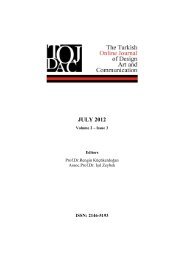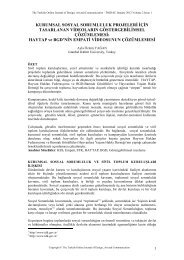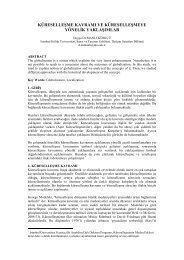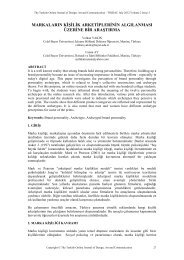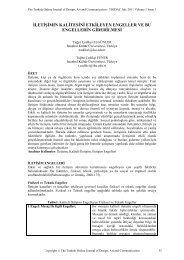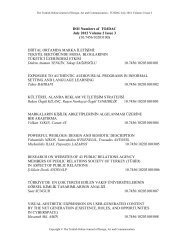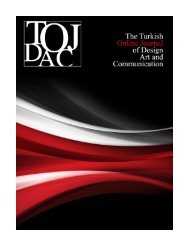aprıl 2012 - tojdac.org
aprıl 2012 - tojdac.org
aprıl 2012 - tojdac.org
You also want an ePaper? Increase the reach of your titles
YUMPU automatically turns print PDFs into web optimized ePapers that Google loves.
The Turkish Online Journal of Design, Art and Communication - TOJDAC April <strong>2012</strong> Volume 2 Issue 2<br />
WHEN OPINION LEADERS TWEET: FRAMING ANALYSIS OF<br />
KUWAITI PARLIAMENT MEMBERS’ TWEETS<br />
Fatima Al SALEM<br />
Indiana University, School of journalism, USA<br />
alsalem_fatima@yahoo.com<br />
ABSTRACT<br />
This research investigated Kuwaiti parliament members’ leadership behavior on Twitter by<br />
applying Bolman and Deal’s (1984) leadership theory of framing. The study classified parliament<br />
members according to their political party affiliation-Islamists, independents, liberals, and<br />
populists party- and investigated the prevalence of four leadership frames through a content<br />
analysis of eight parliament members’ messages on Twitter over a period of six months from June<br />
15, 2011 to November 15, 2011. Results showed that, overall, the structural frame was the most<br />
commonly used frame among parliament members, followed by the political, symbolic, and<br />
human resource frame respectively. The use of frames depended on both the political group and<br />
the topic of issues. The Islamist group, liberal and populist party more often used the structural<br />
frame in their Twitter messages whereas the independent group more often used the political<br />
frame.<br />
Keywords: Opinion leaders, Twitter, New media, Framing<br />
1. INTRODUCTION<br />
In many ways social media provide an interesting space for opinion expression and political<br />
discourse, and many people speculate its possible democratic implications for people living in<br />
less democratic countries. Twitter as a form of social media extends the opportunity that other<br />
social media offer due to its immediacy, great social interaction, and informal discussion.<br />
Moreover, Twitter is ranked as the fastest-growing site in the member community category in the<br />
U.S., while in Kuwait Twitter users’ penetration is ranked sixth among the Middle East and North<br />
African Countries and third among the Gulf countries (Nielson, 2011; Arab Social Media Report,<br />
2011). An increasing number of Kuwaitis are using Twitter because its free, easy to use, and<br />
provides a space for opinion expression and research found that 24 percent of social media users<br />
in Kuwait use it for political discussion (Alfadhly, 2011). In addition to general users, opinion<br />
leaders in Kuwait such as parliament members (law makers), cabinet ministers, political and<br />
social activists are using Twitter as it represents a channel where they can disseminate ideas,<br />
build on their social capital, interact collaboratively, and build on their public image. The study is<br />
noteworthy in many ways. First, it fills a gap in research as there is dearth of research relating to<br />
framing social media users’ leadership behaviors. Second, the study contributes to framing theory<br />
and the leadership theory of framing by Bolman and Deal (1984) in several ways.<br />
The study demonstrates yet another area within mass communication scholarship in which the<br />
framing theory may be usefully applied to social networking sites. For leadership theory of<br />
framing by Bolman and Deal (1984), this study marks one of the initial examination of the theory<br />
in the political communication arena. In addition, this study extends the theory by introducing a<br />
non-<strong>org</strong>anizational landscape and builds on recent effort by scholars. Lastly, Kuwait’s media<br />
system is interesting in many ways, although the country has a strict press and publication law<br />
that limits the criticism of the Amir and Islam, there is an unfiltered Internet access. The<br />
Copyright © The Turkish Online Journal of Design, Art and Communication<br />
123



